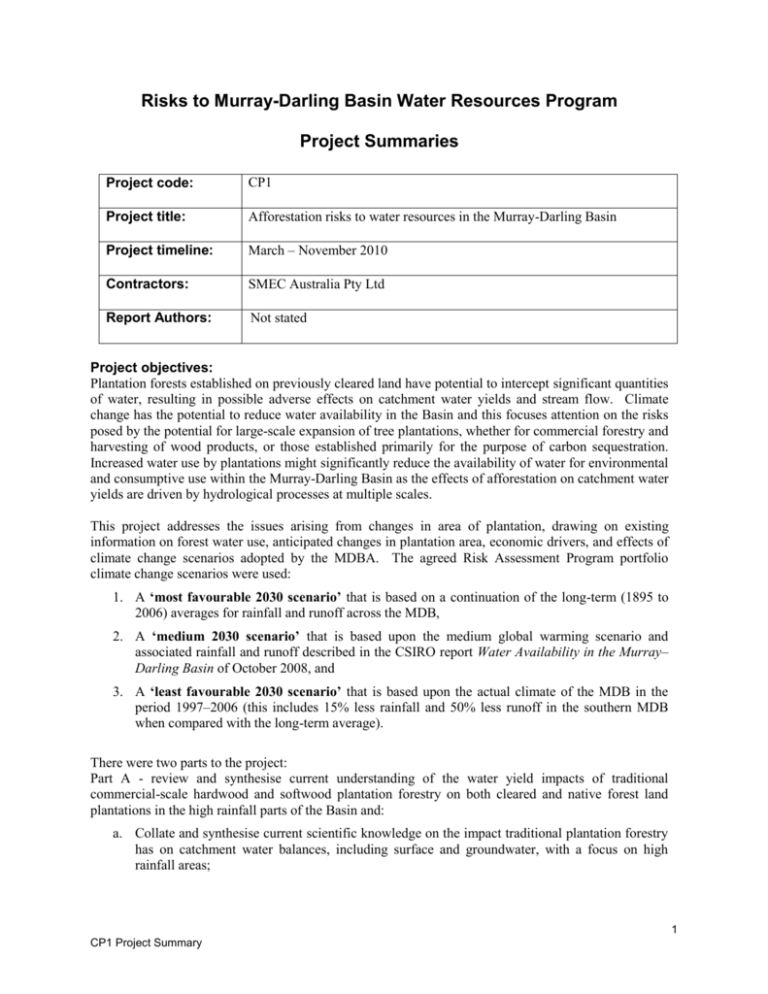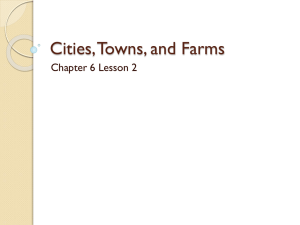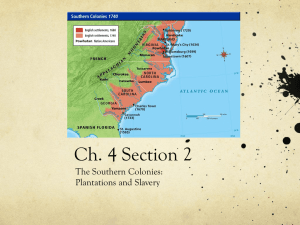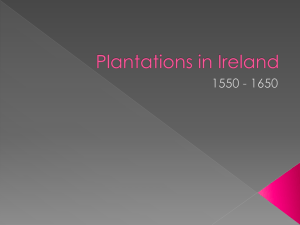Murray Darling Basin Authority
advertisement

Risks to Murray-Darling Basin Water Resources Program Project Summaries Project code: CP1 Project title: Afforestation risks to water resources in the Murray-Darling Basin Project timeline: March – November 2010 Contractors: SMEC Australia Pty Ltd Report Authors: Not stated Project objectives: Plantation forests established on previously cleared land have potential to intercept significant quantities of water, resulting in possible adverse effects on catchment water yields and stream flow. Climate change has the potential to reduce water availability in the Basin and this focuses attention on the risks posed by the potential for large-scale expansion of tree plantations, whether for commercial forestry and harvesting of wood products, or those established primarily for the purpose of carbon sequestration. Increased water use by plantations might significantly reduce the availability of water for environmental and consumptive use within the Murray-Darling Basin as the effects of afforestation on catchment water yields are driven by hydrological processes at multiple scales. This project addresses the issues arising from changes in area of plantation, drawing on existing information on forest water use, anticipated changes in plantation area, economic drivers, and effects of climate change scenarios adopted by the MDBA. The agreed Risk Assessment Program portfolio climate change scenarios were used: 1. A ‘most favourable 2030 scenario’ that is based on a continuation of the long-term (1895 to 2006) averages for rainfall and runoff across the MDB, 2. A ‘medium 2030 scenario’ that is based upon the medium global warming scenario and associated rainfall and runoff described in the CSIRO report Water Availability in the Murray– Darling Basin of October 2008, and 3. A ‘least favourable 2030 scenario’ that is based upon the actual climate of the MDB in the period 1997–2006 (this includes 15% less rainfall and 50% less runoff in the southern MDB when compared with the long-term average). There were two parts to the project: Part A - review and synthesise current understanding of the water yield impacts of traditional commercial-scale hardwood and softwood plantation forestry on both cleared and native forest land plantations in the high rainfall parts of the Basin and: a. Collate and synthesise current scientific knowledge on the impact traditional plantation forestry has on catchment water balances, including surface and groundwater, with a focus on high rainfall areas; 1 CP1 Project Summary b. Analyse the information in terms of the significance of the water yield impacts to MDB catchments and streamflow, using three climate change scenarios (see above) and taking into account growth projections for the increased establishment of plantations in high rainfall areas. Part B - review and synthesise the knowledge available on multipurpose forest, commercial and non commercial afforestation, in all rainfall areas in the MDB, both current and proposed, that are planted specifically to provide carbon sequestration benefits. The impacts of these plantings, both positive and negative were to be assessed, including impacts on water yield, salinity management, biodiversity and riparian management. The objectives were to: a. Achieve a clear understanding of the current scientific knowledge and gaps on the impacts of afforestation for carbon sequestration benefits and the impacts on catchment water balances, by reviewing existing knowledge and detailing approaches previously undertaken and limits to previous and current studies; b. Identify current legislation and policies in each jurisdiction relating to afforestation for carbon sequestration, with a focus on the water use impacts of these policies; c. Identify current and proposed rates of increase and/or decline of afforestation types across the MDB, areas which may be most impacted and associated land use changes. This might involve collating proposed land uses and guidelines for development in each jurisdiction; d. Using this information, design a framework and undertake an assessment of the potential impacts, both positive and negative, that afforestation for carbon sequestration is having or will have on a catchment and basin-wide scale, under three climate change scenarios. Potential impacts on the factors listed below should be included: i. Water quality and quantity ii. Salinity management iii. Biodiversity iv. Riparian management v. All potential impacts resulting from land use change e Catchments most likely to be impacted should be listed in order of priority (based on probability and scale of impact). f Provide advice on how carbon plantings can maximise environmental benefits, including identifying suitable areas for afforestation, and forest management options; and g Develop options for incorporating afforestation for carbon sequestration benefits into water access entitlement frameworks by 2011. Methods: Interviews were conducted with seventeen selected leaders from the forestry industry, leading catchment hydrology scientists, and independent thinkers on catchment management and climate change. Emphasis was placed on selecting respondents (list provided in report) with information and knowledge about previous projects and industry trends. The interviews were designed to quickly identify key issues and recent finding, and to provide access to relevant data and literature. A standardised interview questionnaire was designed to ensure consistency in questions asked and interviews were undertaken through a mix of face-to-face meetings, telephone interviews and emailed responses. Interview results were brought together with literature and data searches to develop a synthesis of all readily available information as a cohesive analysis of pertinent published information and expert opinion. 2 CP1 Project Summary Part B also included a comprehensive search of legislation and policy in each State, Territory, and Commonwealth jurisdiction to identify guidelines with explicit, or implicit, implications for afforestation for carbon sequestration, and potential effects on water use and availability. Each Catchment Management Authority or Natural Resource Management group in the MDB was also contacted to obtain information on regional plantation activities and trends. A vulnerability assessment framework was developed and applied to consider the exposure of each sustainable yields region to: afforestation for carbon sequestration; sensitivity to impacts of plantations; impacts expected; adaptive capacity; and resulting vulnerability. Vulnerability was determined for each of the five factors - water quantity, water quality, salinity, biodiversity, and riparian management, as well as for the combined assessment of positive and negative effects. Assessments were completed for a total of twelve scenarios, covering three climate change scenarios, high and low afforestation scenarios, and high and low scenarios for stream flow and other factors. These scenarios developed relative scores that allowed regions to be ranked qualitatively according to the magnitude and likelihood of potential benefits and impacts. Results were integrated to consider ways to maximise the environmental benefits of carbon plantings, and to identify potential decision support tools to assist in designing carbon plantations across a range of spatial and temporal scales. Existing water entitlement frameworks were reviewed for the identified potential impacts of plantations, area planted to deliver carbon sequestration benefits, and existing legislation and licensing arrangements in the MDB jurisdictions. Several options were developed, based on existing and novel approaches, to include water use by carbon sequestration plantations in water access entitlements in the Murray-Darling Basin. Summary of key results: Part A For this part of the project, high rainfall areas (the HRZ) were defined as regions with mean annual rainfall greater than 600 mm y-1. It was found that the effects of plantation water use on catchment water yields are difficult to measure where plantations cover less than 15-20% of catchment area. Consequently, at the basin scale and catchment scale where plantation cover ranges from 0.4% to 4%, effects of plantation water use on catchment water yields are small, and may be below practical detection limits. In sub-catchments less than 100 km2, where plantation cover is greater than 20%, effects on local stream flow may be significant, leading to reduced stream flow and drying of small streams during low flow periods. Tributary inflows progressively reduce the downstream impacts of plantations in sub-catchments with high plantation cover. The greatest risks exist in small subcatchments less than 100 km2 where plantations may occupy close to 100% of catchment area, and where seasonal reductions in stream flow by plantations may be hydrologically and ecologically significant. In relation to likely future increase in area of commercial forestry plantations, the projections for expansion in plantation area in the MDB have declined in the last decade. Initial estimates in 2002 of an increase of 141,400 ha were revised in 2008 to a more modest target of 52,000 ha by 2030. The forestry industry believes that even this target is ambitious, with maintenance of existing plantation area, perhaps with a small increase of around 5%, considered more likely under current conditions. The recent failure of managed investment schemes for forestry, combined with the collapse of several major forestry companies, make it difficult to raise revenue required to establish new plantations. In view of the current uncertain economic outlook for plantation forestry, a significant increase in the area of traditional forest plantations is considered unlikely in the foreseeable future, and consequently, the risk to water yields in the Basin was assessed as being low. However, recent studies suggest that a carbon 3 CP1 Project Summary trading scheme with a high price on carbon ($A28/t or more) may provide economic incentives to drive expansion of plantations, especially in the HRZ regions where biomass accumulation is faster. In relation to climate impacts, a drier climate under the median 2030 scenario, with 9.7% less inflows to the MDB, may see a contraction of traditional plantations to rainfall zones that receive greater than 800 mm y-1 mean annual rainfall. Projected end-of-system flow under median 2030 climate change models suggest a reduction in water yields of 25% across the Basin, with a possible decrease of 69% in dry extremes. Against this range of changes, the estimated reduction in end-of-system flow of 0.8% attributable to a 52,000 ha increase in plantations is small, and actual change is expected to be even smaller if industry projections are correct. Recent analyses suggest that the adaptive capacity of forests to climate change through changes in vegetation seasonality, rooting depth, depth of rain penetration in soil, and CO2 effects, may partially offset the effects of forests on stream flow. The net effect of forest adaptation is that impacts on water availability under drier 2030 climate scenarios may be less than current predictions. In summary, Part A concluded that under the median 2030 climate change scenario, a 0.8% reduction in stream flow following a 52,000 ha increase in traditional plantation area (the 2008 estimate) is likely to be masked by other sources of variation, such as climate variability. The same increase in plantation area under the least favourable dry extreme 2030 climate scenario will reduce end-of-system flow by 1.6% compared to the 69% reduction caused by climate change itself. The risk to water yields will be much smaller than these estimates if industry projections of less than 5% expansion in plantation area are achieved. Conversely, if an expansion of 141,400 ha is realized (the 2002 estimate), effects on water yields may be roughly estimated as a 2.4% reduction in end-of-system flows, and a 0.36% reduction in total water resource availability. These changes are still small compared to the expected effects of climate change and the estimated 4.9% reduction in stream flow by new farm dams. The current trend toward smaller plantations distributed more widely may reduce effects on individual streams. Part B The effects of water use by carbon plantations on catchment water yields differ from the effects of traditional forest plantations in several key ways. 1. carbon plantations are most likely to be established in regions with lower rainfall, since areas with greater than 600 mm y-1 rainfall are in demand for more valuable forms of production, such as agriculture or plantation forestry for wood production. Therefore, although the greatest sequestration rates occur in HRZs, economic drivers are likely to force most carbon plantations toward low rainfall zones unless carbon prices are high. 2. land suitable for carbon plantations tends to lie in low gradient parts of the Basin that are characterised by low runoff and high evapotranspiration rates. Consequently, effects of carbon plantations on water resource availability are likely to be less than effects of plantations in higher rainfall regions. 3. the lower water availability to plantations in low rainfall areas means that different tree species, with different water requirements, are favoured in plantations intended to provide carbon sequestration benefits. Environmental plantations are often established primarily for other benefits such as salinity management or habitat restoration, with carbon sequestration as a secondary benefit. Many species, for example oil mallees, can be grown in areas with very low reliable rainfall, but plantations established primarily for carbon sequestration are probably not economically viable in areas with less than 300 mm y-1. Whilst plantations may reduce salinity impacts by lowering water tables or by intercepting saline groundwater before it enters rivers, trees may also intercept freshwater that dilutes saline discharge, resulting in increased salinity in some situations. 4 CP1 Project Summary 4. Carbon plantings that contain a number of species are likely to make greater contributions to biodiversity goals than monocultures. Environmental plantings account for approximately 14,000 ha (5%) of the total 284,000 ha of plantations in the Basin. Interest in environmental plantings for carbon sequestration varies markedly among catchment management groups. Significant private investment in environmental plantings has not yet occurred in the MDB, with private plantations limited to 100 ha or less. Lack of investment is considered to be the major obstacle to environmental plantation establishment in suitable regions. Despite strong interest in establishing carbon plantations in some regions, the area of existing plantations is small and is unlikely to grow significantly in the short to medium term. Possible expansion in carbon plantings to 2030, based on current rates, is estimated at 100,000 ha. Economic modelling based on a carbon price of $A28 tonne-1 indicated a hypothetical increase in plantations of over 10 million ha by 2050, which was re-scaled to approximately 5 million ha by 2030 for comparative purposes. The vulnerability assessments drew upon projected plantation areas in each of the MDB regions delineated in the sustainable water yields study, to provide a spatial comparison and ranking of vulnerable regions within the Basin. Estimated changes in end-of-system flows as a result of maximum afforestation under the median 2030 climate scenario varied from 0% in the Paroo and Ovens catchments, to a reduction of 14% in the Border Rivers catchment. Vulnerability of catchment water yields by 2030 is low at the catchment scale if plantations increase at the current rate. In contrast, vulnerability increases significantly under any scenario where the price of carbon is high enough to provide incentives for landholders to convert marginal agricultural land to carbon plantations. Vulnerability of water yields, and benefits to other environmental purposes are assessed as being greatest in the Eastern Mount Lofty Ranges, Moonie, Gwydir and Macquarie-Castlereagh catchments. A wide range of differing statutory tools is used in different jurisdictions in relation to afforestation for carbon sequestration, and cover issues of forestry, water, climate change, land use and planning, environment, and vegetation management. Carbon sequestration plantations are encouraged by a raft of legislation and policies at national, state and local government levels. Much of the relevant legislation has been enacted only recently, and responsibility for implementation is often diffused among different levels of government and multiple agencies, potentially leading to inconsistent application. Five options are presented to allow water use by carbon sequestration plantations to be included in water access entitlement frameworks, based on access entitlements for regulated surface water, unregulated surface water, and groundwater systems: i. Purchase of environmental allocation from the Commonwealth Environmental Water Holder. ii. Water licence tender. iii. Afforestation of land with existing bundled water rights. iv. Payments for environmental services (or contracts for afforestation services). v. A new afforestation entitlement across the Murray-Darling Basin. Overall, Part B concluded that estimates of increases to 2050 in plantation area for environmental purposes, including those established primarily for carbon sequestration, across the Basin range widely from a minimum of 100,000 ha to over 10 million ha driven largely by the existence of a price on carbon emissions. An increase in carbon plantings driven by a carbon price of $A28 tonne-1 results in a 13% reduction in catchment water yields, and an 8% reduction in end-of-system flow across the Basin by 2050, in addition to effects under the median 2030 climate change scenario. Catchments with large areas of low land values in the low rainfall zone are vulnerable to reduced water yields and stream flows 5 CP1 Project Summary as a result of converting agricultural land to large-scale carbon sequestration plantations. Additional benefits are likely to be achieved by optimising objectives for water quality, salinity management, biodiversity and riparian management. The uncertainty surrounding the influence of economic and other drivers on the potential increase in carbon sequestration plantations creates a wide range of possible impacts on water availability within the Basin. Under current rates of afforestation, the risk to catchment water yields and stream flow is very low. However, the potential for reduced water availability resulting from large-scale plantation establishment exceeds the projected reduction under the median 2030 climate change scenario in some regions, and presents a significant risk to water resources and ecosystems. The adaptive capacity of plantations under a drier climate may partially offset increased water use by new plantations established for carbon sequestration. It would be prudent to reassess the conclusions from this study when there is greater certainty regarding the price of carbon. Comparisons with other projects: The findings of this project broadly match those of project CP2 which examined effects of changed land use and forestry practice. They also take account of the likely effects of climate change on tree water use. Knowledge gaps identified: The greatest sources of uncertainty uncovered by this project are the potential increase in plantation area and the effect on this of future prices for wood products, the level and effects of a future carbon price, and the most likely climate trajectory. Other sources of uncertainty and identified knowledge gaps include: - Difficulties in extrapolating effects of plantation increase at large catchment scales; - A lack of agreed methods for dealing with climate variability in hydrological models; - The different processes represented in models used to estimate plantation water use; - Limited data about the contribution of plantations to water use compared to other land uses, including plantations established for carbon sequestration and other multiple uses; - Limited understanding of the role of forests and plantations in atmospheric coupling between evapotranspiration and precipitation; - Lack of monitoring data about plantation water use and impacts on water yields, including for mixed-use plantations in lower-rainfall areas; - Low ability to assess the significance of plantation water use at different spatial scales; - Lack of data on the net benefits of plantations in relation to water use; - Lack of data on the impacts of climate change on plantation water use; and - Uncertainty in the global economic outlook, especially in relation to plantation products, demand and price, carbon policies and prices, and the value placed on water resources. Implications for policy: Several factors described by this project could have significant effects on the total area, location and types of plantations within the MDB, and hence on their impacts on water resources. These factors, and their effects, could change quite quickly, and this means that the MDBA and jurisdictions will need to regularly access current knowledge and data about them and to keep them and their likely effects under review. 6 CP1 Project Summary This project has also identified several further sources of uncertainty and knowledge gaps that affect the accuracy and scale of the analyses made. It has been suggested that these gaps be addressed so that the analyses can be repeated in future with greater confidence, and the ability to provide more-detailed information at scales relevant to the plans and decisions of catchment authorities and other NRM organizations. At the same time, responsible agencies could examine and improve the legislative and regulatory framework within which plantation establishment is governed and monitored, to make sure that if and when significant changes become likely, their effects on Basin water resources can be anticipated and managed effectively. Recommended Communication Approach: The Final Report, including both parts of the study, should be made widely available in electronic format as it contains much valuable discussion of the modelling used and of the detailed results obtained. The project team should be encouraged to present their findings at workshops and conferences, and it would be useful to have them present at a forum with the related project CP2 as there are clear synergies between the two studies. 7 CP1 Project Summary









